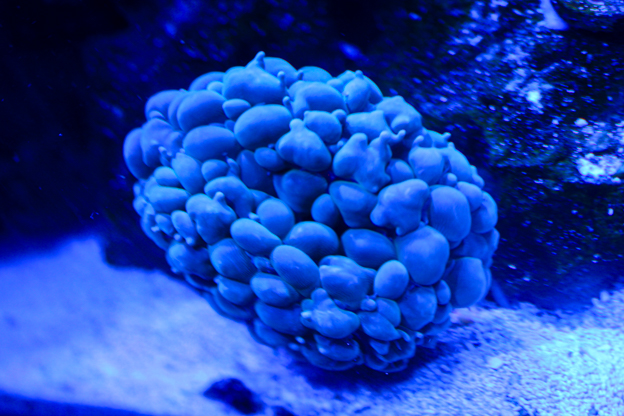Bubble Coral (Plerogyra sinuosa)
• Common Name: Bubble Coral
• Scientific Name: Plerogyra sinuosa
• Class: Anthozoa
• Origin: Indo-Pacific, Red Sea, Australia, Indonesia
• Category: LPS (Large Polyp Stony Coral)
• Care Level: Intermediate
• Temperament: Aggressive (long sweeper tentacles)
• Lighting: Low to Medium (PAR 50-150)
• Flow: Low to Moderate (gentle, indirect flow)
• Placement: Bottom to Middle (rock crevices or sandbed)
• Growth Rate: Slow to Moderate
Overview:
Bubble Coral (Plerogyra sinuosa) is a unique and visually striking LPS coral, known for its inflated, bubble-like vesicles that expand during the day. These bubbles help maximize light absorption and protect the coral’s delicate tissue. At night, the bubbles retract, revealing long, powerful sweeper tentacles that it uses for feeding and defense.
Bubble Corals are relatively hardy and can thrive in moderate reef conditions, but they require ample space due to their aggressive nature.
Tank Requirements & Water Parameters:
Bubble Coral thrives in stable water conditions with moderate nutrients:
• Temperature: 76-80°F (24-27°C)
• pH: 8.1-8.4
• Salinity: 1.024-1.026 SG
• Alkalinity: 8-10 dKH
• Calcium: 400-450 ppm
• Magnesium: 1250-1350 ppm
• Nitrate: 5-15 ppm (moderate nutrient levels)
• Phosphate: 0.03-0.1 ppm
Bubble Corals do not tolerate rapid parameter swings well, so stable alkalinity and calcium levels are critical for skeletal growth.
Lighting Needs:
Bubble Coral prefers low to moderate lighting (PAR 50-150).
• Too much light can cause bubbles to shrink and retract.
• Too little light can slow growth and cause fading.
• Gradually acclimate them to higher light to prevent stress.
Tip: Place them in a shaded area or under indirect lighting for best expansion.
Flow Requirements:
• Low to moderate, indirect flow is best.
• Too much flow can cause bubbles to deflate and may lead to tissue damage.
• Avoid direct blasts from powerheads, as strong currents can tear delicate bubble tissue.
Feeding & Nutrition:
Bubble Coral is photosynthetic but benefits from supplemental feeding, especially at night when its sweeper tentacles extend.
• Ideal Foods:
• Mysis shrimp
• Brine shrimp
• Reef Frenzy, Benepets, Coral Frenzy
• Powdered coral foods (e.g., Reef Roids)
• Feeding Frequency: 1-2 times per week to enhance growth and coloration.
Tip: Target feeding at night when tentacles are extended allows for better food capture.
Placement & Aggression:
• Placement: Bottom to middle of the tank, in a rock crevice or stable sandbed.
• Aggression: Highly aggressive—Bubble Coral has long, powerful sweeper tentacles (up to 6 inches!) that sting and kill nearby corals.
Tip: Keep at least 6-8 inches of space between Bubble Coral and other corals to avoid damage.
Growth & Propagation:
Bubble Coral grows slowly to moderately, forming large, fleshy colonies over time. Unlike branching LPS corals, it grows as a single polyp with a large skeletal base.
Fragging Bubble Coral:
• Use a bandsaw or rotary tool to carefully cut through the skeletal base.
• Avoid damaging soft tissue, as torn tissue can lead to infection.
• Allow frags to heal in low-flow areas before reintroducing them into the main tank.
Popular Color Variations:
Bubble Coral comes in several stunning color variations, including:
• Neon Green Bubble Coral – Bright green bubbles with fluorescent highlights
• White Pearl Bubble Coral – Soft white or pale green bubbles
• Metallic Gold Bubble Coral – Golden-tinted vesicles (rare and sought-after)
• Blue Bubble Coral – Deep blue or teal undertones under actinic lighting
Challenges & Common Issues:
• Tissue Damage: Delicate bubbles can tear if handled roughly or placed in high flow.
• Recession & Shrinking: Often caused by unstable alkalinity, excess light, or too much flow.
• Brown Jelly Disease: A bacterial infection that causes rapid tissue necrosis—remove affected areas immediately to prevent spread.
• Overgrowth of Algae or Cyanobacteria: Occurs if detritus settles on retracted tissue. Maintain stable flow and clean the coral gently if needed.
